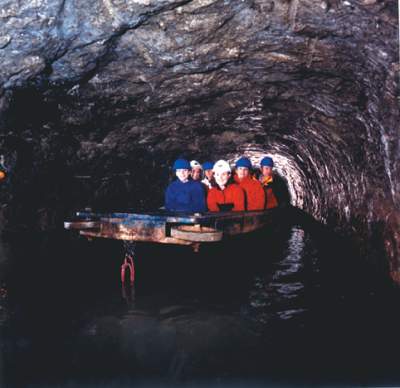Castleton
Castleton is one of the most beautiful villages in the Peak District. It has an array of natural and historical features both above and below ground, and is surrounded by superb walking country. Whatever the weather Castleton has something to offer everyone. High above the village stand the imposing ruins of Peveril Castle. The castle was completed in 1086 for William Peverel, a favoured knight of William the Conqueror (although there is no proof that he was William's illegitimate son as is sometimes thought).
To the west of Castleton lies Mam Tor, which is locally known, as the shivering mountain. Topped by an iron-age hill fort, whose ramparts are clearly still visible, this shale hillside looms large over the valley. From there runs The Great Ridge, past Hollins Cross to Losehill Pike at the eastern end. Overlooking the two valleys of Hope and Edale, and giving stunning views, Mam Tor Ridge is a popular local walk.
Castleton is now famed for its four show caves, once all lead mines, each offering a different experience to the visitor, although the only cave in the village itself is Peak Cavern.
Speedwell Cavern
Speedwell Cavern is set at the foot of the spectacular Winnats Pass, high above the village of Castleton. You go down 106 steps and board a boat that takes you through the workings of a 230 year old lead mine. Your guide recounts what it must have been like to carve out these tunnels using only the most primitive hand-tools, and tells you the story of the mine which opens into a huge natural chamber, the Bottomless-Pit Cavern. Speedwell Cavern is open daily throughout the year (except Christmas Day). Tours leave at regular intervals through the day, and last for between 30 minutes and 1 hour. Like most caves in the area it is not suitable if you suffer from Claustrophobia. There is a gift shop on site selling a wide range of souvenirs, minerals, rock and fossils together with jewellery set with the local Blue John Stone. There is more information on the Cavern’s web site www.speedwellcavern.co.uk

Treak Cliff Cavern
Treak Cliff Cavern has two distinctly different series of caves. The first half is full of minerals and fossils including the local fluorspar unique to the area, called Blue John. As you walk through the cave, veins of the stone are visible and the cave contains the largest known single piece of Blue John in The Pillar. The second half of the cave is completely different, resembling a fairytale world of stalactites and stalagmites.
Peak Cavern
Unravel the mysteries of the Devil’s Arse and step into the unique world of Peak Cavern. Unusual rock formations, the eerie sound of running water and echoes of a bygone age await you.
Set in the middle of the picturesque Peak District village of Castleton, the approach to Peak Cavern is awe inspiring.
A riverside walk takes you past centuries old miners’ cottages, opening out into a spectacular limestone gorge. Before you are 280ft high vertical cliffs with the ruins of Peveril Castle towering above.
Deep into the cliffs is the Cavern’s imposing entrance chamber — the largest natural cave entrance in the British Isles.
Within this entrance chamber you will see the remains of an ancient village where a whole community lived and worked making ropes for the local lead mines for more than 400 years.
As you venture deeper into the Cavern and stoop to go through Lumbago walk you will hear the remarkable acoustics of the Orchestral Gallery in the Great Cave, see a perpetual cascade of water at Roger Rains’ House, pass through Pluto’s Dining Room into the Devil’s Cellar where you can hear the source of the river Styx.
Effective lighting systems highlight the splendour of the cavern’s chambers with their unusual flowstone and stalactite formations to enhance the experience of your visit to this famous location.
Guided tours which include traditional ropemaking demonstrations are available at frequent intervals, each lasting about 1 hour. The tours are fairly undemanding and are suitable for all ages.
Blue John Mine, opposite Mam Tor, is the deepest of the caves and also contains Blue John stone, but its real beauty is in the vastness of the cave system.
A medieval leper hospital (the Hospital of Saint Mary in the Peak) is thought to have been on the eastern boundary of Castleton, though some locals believe it to have been just south of the Speedwell Cavern footpath from the village.
Castleton is a special place to visit any time of year. Be it for walking, caving, taking in the magical spectacle of the Christmas lights, watching the historical Castleton Garland (end of May) or enjoying the variety of restaurants, cafes, pubs and hotels the village and surrounding area has to offer.